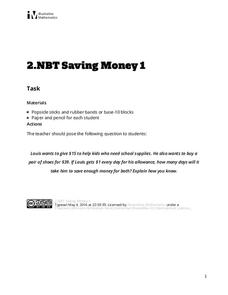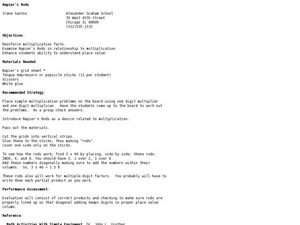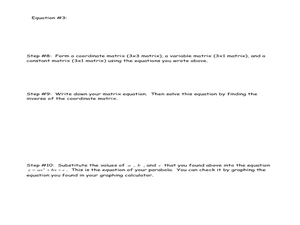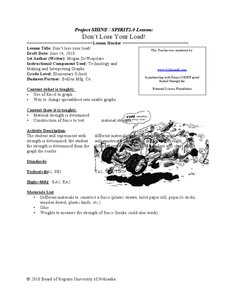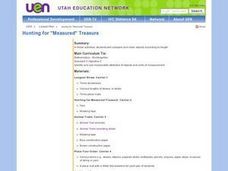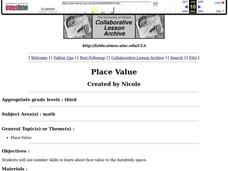Curated OER
Popsicle Stick Regrouping Fun
Students demonstrate regrouping in subtraction. In this math computation lesson, students use popsicle sticks to practice the regrouping strategy. Students practice several examples of regrouping problems in small groups.
Illustrative Mathematics
Saving Money 1
How many days will it take Louis to save enough money for school supplies and new pair of shoes? Focus on Common Core math standards with a two-part task that involves a word problem and counting manipulatives.
Curated OER
Napier's Rods
Young mathematicians explore the concept of multiplication using Napier's Rods. They use Popsicle sticks to create a 3D model of Napier's Rods. Pupils multiply multiple digit numbers using Napier's Rods.
Curated OER
Fraction Popsicle Pop-ups
Students decorate and use popsicle sticks to use as manipulatives to assist with their learning of fractions. They play learning games with their popsicle sticks with a partner.
Curated OER
Popsicle Place Value
Students use popsicle sticks to represent place value. They practice grouping the popsicle sticks in groups of tens and ones to represent numbers given by the teacher.
Illustrative Mathematics
Roll & Build
Develop young mathematicians' understanding of place value with this hands-on math activity. Working in pairs, learners take turns building two-digit numbers by rolling two ten-sided dice. Base ten blocks are then used to model the...
Curated OER
What's The Idea?
Sixth graders explore line segments, rays, parallel, perpendicular and intersecting lines. The teacher discusses, with the class, real life items that represent each geometric idea studied. They use cotton balls, strings and popsicle...
Curated OER
Adapting the Game Concentration
I love classroom games, and this plan deftly describes how you can use the game Concentration across the curriculum to reinforce skills. I wish I would have thought of this when I was teaching this age level. These kinds of games are...
Curated OER
One Hundred Things
Learners practice estimating by handling items in groups of ten. They visualize how much space 100 items, such as pennies, peas, or beans, will take up after holding 10 of them. Students measure the difference in volume between 10...
Agriculture in the Classroom
Pumpkins... Not Just For Halloween
Celebrate fall with four pumpkin themed hands-on activities! After learning about pumpkins, scholars complete two activity sheets that reinforce estimation and word problems. They then plant pumpkin seeds and bake a pie in...
Curated OER
Measurement: Perimeter and Area
In this perimeter and area lesson, students learn the formulas for perimeter and area and view model problems using tiles. Students work in groups to solve practice problems. Students define perimeter and area and explain why...
Curated OER
Intro to Mayan Numbers
Students investigate Mayan Numbers. In this algebra lesson plan, students compare our number system to the number system of the Mayans. They identify base 10 and base 20 numbers including zero in the Mayan symbols. They solve a Mayan...
Education World
Greater Than or Less Than With "Mr. Great"
Those tricky symbols for greater than and less than have stumped young mathematicians for generations. Mr. Great is a paper plate cut into a Pac-Man shape that can be used to keep track of which direction the symbols should face. This...
Curated OER
I Can Use a Worm to Count
Kindergarteners use worms, puppets or other props to practice counting to 100. First, they listen to a read aloud of Count Worms by Roger Hargeaves. A worm pattern is used to count to 100, with each segment of the worm...
Curated OER
Children's Literature Across the Curriculum Ideas-The Very Hungry Caterpillar
Learners read The Very Hungry Caterpillar by Eric Carle. They complete a variety of cross-curricular activities surrounding the study of caterpillars. Included are reading, art, math, science, writing, social studies, and library...
Curated OER
Quadratic Equations and Parabolas
Students graph and solve quadratic equations. In this functions lesson, students analyze a quadratic equation using three points on a curve to define the graph of a quadratic function. They find the vertex and intercepts of the graph.
Curated OER
Don't Lose Your Load!
Pupils create graphs using collected data. In this algebra instructional activity, students use spreadsheet in Excel to create graphs to interpret their data and make predictions. They rewrite word problems using algebraic expressions.
Curated OER
Measurement Mania
First graders measure 10 different objects found in the classroom, including their own hands and feet, then record their findings. This is a fun instructional activity for students to experience measurement using a ruler and unifix cubes.
Curated OER
Hunting for "Measured" Treasure
Pupils compare and order objects according to length. They see that to conserve length, meaning that the length of an object is not altered by a change in its spatial position, even though it may appear to look longer or shorter than...
Curated OER
Hunting for Measured Treasure
Students compare and contrast objects according to their length. In groups, they travel to different centers in their classroom to participate in different sorting activities. They are introduced to how to use a ruler and reading the...
Curated OER
Place Value
Students use various manipulatives and play a game to practice place value and to help them visually see how many "ten" is.
Curated OER
Subtracting Monkeys
Students sing a song that counts backwards from five to one and illustrate the countdown with puppets. They write the correct subtraction problem for each verse of the song.
Curated OER
More or Less? Mouse or Elephant?
Second graders have fun predicting the relative sizes of answers to addition and subtraction problems using their animal friends. When the lesson is finished, give each student two cookies for a job well done.



